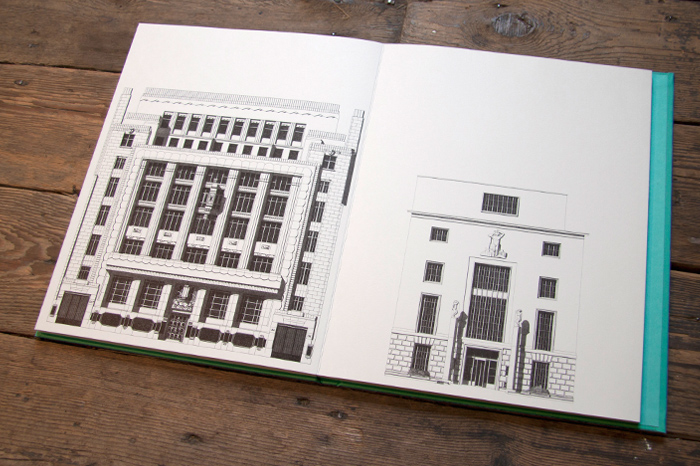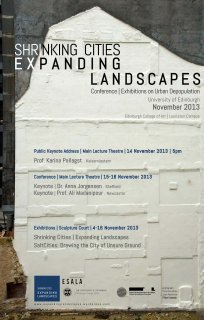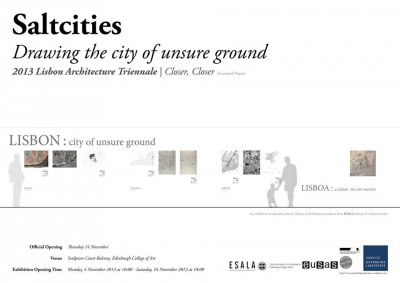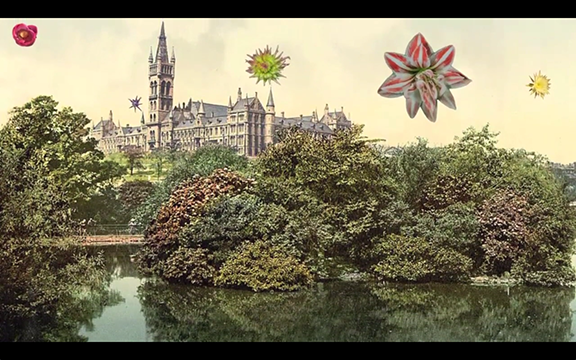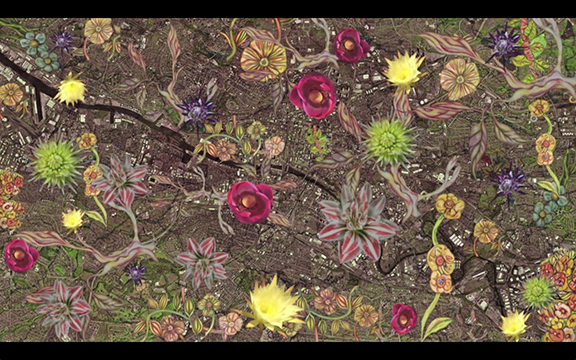Yasmin Ali
Urbanism // Design
London Deco
December 6th, 2013
Architectural illustrator Thibaud Herem's London Deco is a recent release from London-based independent publisher Nobrow Press. Everything about this book exudes the finest quality and attention to detail: from the intricate rapidograph ink drawings, to its large-scale concertina format, its Fabriano 200gsm paper and hardback binding.
Herem has faithfully documented in great detail the facades of eleven examples of London art deco architecture. These include the icons The Hoover Factory, BBC Building and the much-loved Battersea Power Station, now Tate Modern, as well as some lesser-known and smaller-scale gems such as theatres, car workshops, Southgate Underground Station (now decommissioned), and Islington's Screen on the Green. RIBA's headquarters also fittingly makes an appearance.
This is part of the Nobrow Leprello series, which takes its namesake from the Italian for 'concertina'. The book folds out to be 3 metres long, and on the reverse are charming silhouettes of the buildings, each with a brief history. The hand drawn images themselves are amazingly intricate, with no digital enhancements.
London Deco makes a beautiful and affordable Christmas gift for architects, and the current first edition is one to treasure for years to come.
--
Nobrow Press, Published October 2013, 20pgs, Hardback, 240 X 300mm, £25
Available at Nobrow shop and website, and RIBA Bookshop.
--
Weblinks
Nobrow - here
Thibaud Herem - here
Shrinking Cities : Expanding Landscapes - Conference Review
November 21st, 2013
ESALA organised and hosted a three-day interdisciplinary design conference from 14th-16th November seductively-titled 'Shrinking Cities: Expanding Landscapes'. The programme included three keynote lectures and four panel discussion cross-cutting a range of discourses, including landscape architecture, urban planning, geography, sociology and urban design. The overarching premise was to break down the silos between these disciplines and encourage dialogue and shared interests regards themes of depopulation and urban sprawl.
Dr. Karina Pallagst, author of the reader 'Shrinking Cities: International Perspectives and Policy Implications, opened the conference with a public keynote address, on the evening of the 14th, followed by a reception and exhibition of related artwork, alongside a second exhibition of Masters' work from current architecture students at ESALA.The conference began in earnest for delegates on the 15th, with a keynote presentation from Dr. Anna Jorgenson of The University of Sheffield, who spoke of the potential role of green infrastructure in shrinking cities, and the evolving role of landscape architecture throughout history.
The morning continued with the first panel discussion based on three separate talks from scholars from Greece, Italy and Edinburgh. Evangelina Athanassiou from The University of Thessanoliki recounted the city's grassroots' measures for its contested public spaces in the wake of the recent fiscal crisis. Paola Sabbion, a PhD candidate from The University of Genoa, gave a theoretical talk discussing the dialectics of the void and its role in the essence of landscape for her paper of the same title. Finally, Lisa Moffit, an academic at The University of Edinburgh presented ideas based on entropy as a means of expression of the spatial and temporal qualities of post-industrial landscapes.
The afternoon featured two panel discussions, the first of which featured two engaging self-initiated research projects, plus an interesting presentation on a German response to excess urban space and housing stock. The first was from John Bingham-Hall of UCL who went to Detroit to set up an open-studio gallery, documenting the features of public space around the city, together with his project collaborator, photographer Lucinda Chau, to provide a counter-image to the current festishised images of wastelands popularised by urban explorers/photographers. The second project was by anthropologist Caterina Borelli who spent a year in Sarajevo documenting and studying citizen's attitudes and the current state of its Mountain, Mont Trebevic, which has been somewhat divorced from the city since its use in the Bosnian-Serb war of 1992-95 as a siege point. The closing panel discussion included a presentation from a spatial and policy planning perspective from Stefanie Roessler. East Germany has shrinking municipalities, and has invested in an urban restructuring state programme (Stadtumbau Ost), which managed the demolition of 300,000 flats to help stabilise the housing market. The flipside is the implication for greenspace development and the resultant increase in vacant sites.
The closing panel discussion of the day featured three excellent talks themed around the notion of urban vacancy from American academics. Galen Newman from Texas A&M University introduced the concept of urban shrapnel to describe the interstitial biproduct of creating urban spaces. In a clear and well-structured presentation, Newman elaborated on this concept discussing the spatial distribution of non-productive spaces; deindustrialisation; and typologies of underused unproductive space. Kees Lokman from Washington University in St. Louis, presented an essay entitled 'Vacancy as a Laboratory: Toward an Urban Land Ethic'. This focused on the potential of restoration ecology as a strategic framework to raise the economic, ecological and cultural value of vacant lots. Lastly in this series, Sandra Albro and Sean Burkholder presented a paper discussing stormwater management in communities with 'gap-tooth vacancy'. This problem is discussed in its context of cities in the Great Lakes region of the US, which can be funded from sources at a regional or federal level, with careful selection of location and scale of site-specific projects.
The conference continued the following morning with the fourth panel discussion of which two talks were presented. The first of these was from William Allen, from US NGO The Conservation Fund, whose work has inspired research in the UK and Europe. Allen discussed a green infrastructure framework for shrinking cities by defining green infrastructure planning and functional landscapes regards shrinking cities and offering an operational framework. Project selection undergoes an objective process known as suitability analysis by computer and logic scoring preference (LSP). Allen underlined the importance of also combining top-down policies with grassroots movements for balanced project prioritisation. The last talk in the final panel discussion again had an American focus, with Alessandra Coppola presenting on 'Alternative Urbanism in the Rustbelt'. This was a general paper in a hybrid research area transcending urban planning, policy, and its appliance. Coppola noted conditions within the US which make its shrinking cities different to those in Europe in terms of demography, including requisites such as poverty concentration; racial segregation; health crisis; economic weakness and fiscal crisis; as well as the real-estate sub-prime mortgages crisis. Coppola termed this combination an operational dystopia built on Keynesian, neoliberal principles, and cited the role of philanthropy and the emerging community development industry and movements as possible saviours.
The closing keynote was led by Prof. Al Madanipour of Newcastle University who gave an inspiring lecture on the spatiality and temporality of interventions on gap sites. He outlines three dimensions to space-time institution gaps, including pragmatic, transformative and existential qualities. Further to these, he notes three perspectives including those of different stakeholders, locating the project in the wider context of socioeconomic change, and the project's location in terms of space and time. Madanipour cites the pop-up shop movement as being currently in vogue and a means of temporary use of 'gaps', as well as the role of artists in reclaiming public space and their use in place-marketing, branding and gentrification.
The closing discussion to the conference tied together themes of scale, space, time, governance and economy regards shrinking cities. Also posited was the potential to counter the Modernist and capitalist assumption that successful cities are meant to grow, and to instead understand cities as fluid and decline as a natural process throughout history. Resilience was a theme alluded throughout the conference, along with capacity-building. Overall, the sessions were highly informative, inspiring and formed interesting reflections on praxis in urban design, planning and landscape architecture.
With Thanks to Mark Eischeid & Francisca Lima of ESALA
Weblinks
Conference website - here
ESALA - here
Situated Urban Detroit - here
ESALA exhibition Saltcities
November 14th, 2013
The 2012-2014 Masters Programme in Architecture at Edinburgh School of Architecture and Landscape Architecture focuses on Lisbon, and is part of the Saltcity studio series led by Suzanne Ewing. This associated exhibition of academic work, subtitled 'Drawing the City of Unsure Ground', speculates on the wider Lisbon-Tagus metropolitan area, and is part of the current Lisbon 2013 Architecture Triennale.
Themes such as materiality, spatiality, borderlands, morphology and topography are explored within drawn and cartographic media. Previous city studios led by Ewing, following the broad themes of the design thesis include Cadiz (2006-2008) and Marseille (2009-11).
// The exhibition runs in the Sculpture Court at Edinburgh College of Art until the 16th November, with an evening reception on the 14th.
Weblinks
Saltcity - here
Lisbon Architecture Triennale (English) - here
City Speculations - here
ESALA - here
Aerostatic Bloomage: a bold vision for The Commonwealth Games 2014
November 6th, 2013Aerostatic Bloomage is an aerial art and urban design project proposed to form a floral skyscape composed of 75 aerostats over the Commonwealth Games in Glasgow in 2014, by art and architect brothers Adrian and Dorian Wiszniewski. Adrian Wizniewski is a renowned artist and alumnus of Glasgow School of Art whose work has been exhibited globally including the Tate and MoMA New York. Dorian Wizsniewski is an architect and academic who leads postgraduate architecture degree programmes at the newly-merged Edinburgh School of Architecture and Landscape Architecture (ESALA), as well as running his own acclaimed practice.
As a concept, aerostatic bloomage received critical acclaim and interest, which has been piqued by the involvement of kickstarter funding and associated development led by ARCH*e, with the support of the project’s authors. ARCH*e is an Edinburgh-based participatory design collective David Clark and Ross McArthur who have continued to project to form a concept film and funding campaign to launch an community-based aerostat to engage with local residents.
There also may be the potential to repeat the concept and devise small-scale interventions around the city and around Scotland, using the skyscape as a stage to celebrate the games ceremonially.
'Beyond Silos: Teaching Green Design', Hattie Harman, A+DS This Friday Presents...002 @ The Lighthouse, 1.11.13, 1-2pm
November 1st, 2013
A+DS has a programme of Friday Lunchtime lectures planned, hosted between 1-2pm at The Lighthouse, in an informal workshop setting. AJ's Sustainability Editor Hattie Harman spoke at the second of these, on the topic of teaching ecological design, including recent work covered and initiatives raised by The Architects' Journal, as well as a brief survey of current facilities in higher education in architecture throughout the UK.
AJ surveyed Part I students regards their stance on sustainable design provision throughout their studies, with surprising results. Although only 30% said that sustainability was a consideration in the choice of their Part I course, 86% considered it when choosing their Part II course, proving green design is high on the agenda for trainees in architecture. In addition, 68% of respondents said that sustainable principles were a central consideration (43%) or core feature (25%) of their design work. Harman plans to follow up the initial survey with further considered questions in the future.
Of Universities currently involved in sustainable architecture programmes, Harman cited The Centre of Advanced Technology in Wales, AA's Hooke Park in Dorset, The Bartlett, Oxford Brookes and Bath University as centres known for their work. In particular, at The Bartlett, CJ Lim's utopic studio unit 'The Imagination of urban ecologies' has yielded interesting theoretical work. In addition, there are a few universtities noted as Centres of Excellence in Sustainable Building Design by The Royal Academy of Engineering. Of these, The Bartlett is one, joined by Loughborough, Sheffield and Heriot-Watt Universities.
The discussion moved to one which encouraged more interdisciplinary working between architecture students and contemporaries of allied disciplines, including engineering. A delegate from Glasgow School of Art spoke of the INTERACT project for 3rd Year students at GSA which allows them to work with engineering and quantity surveying students. Other attendees from Strathclyde School of Architecture spoke of sustainability having been on the curriculum since 1995 and before, along with structure and engineering, all taught embedded in the architectural school as part of the Faculty of Engineering.
The general consensus was that sustainability is something to be taught early in architectural schools, and holistically, though not so diffuse as to become imperceptible.
The event was run in association with SEDA (The Scottish Ecological Design Association), and the current Krystyna Johnson Awards exhibition 2013 for second year architectural students, also hosted at The Lighthouse, until 11.12.13.
AJ runs its Footprint section focusing on sustainability issues in its last print issue of each month.
For further events of A+DS This Friday Presents... see http://www.ads.org.uk/access/features/this-friday-presents or Follow @ArcDesSco on Twitter. Entry to talks cost £3 and include tea or coffee.
The next in the series is 9th November, 'Poor Change, Loose Fit', James Mitchell of Orkidstudio. Tickets available online here.



